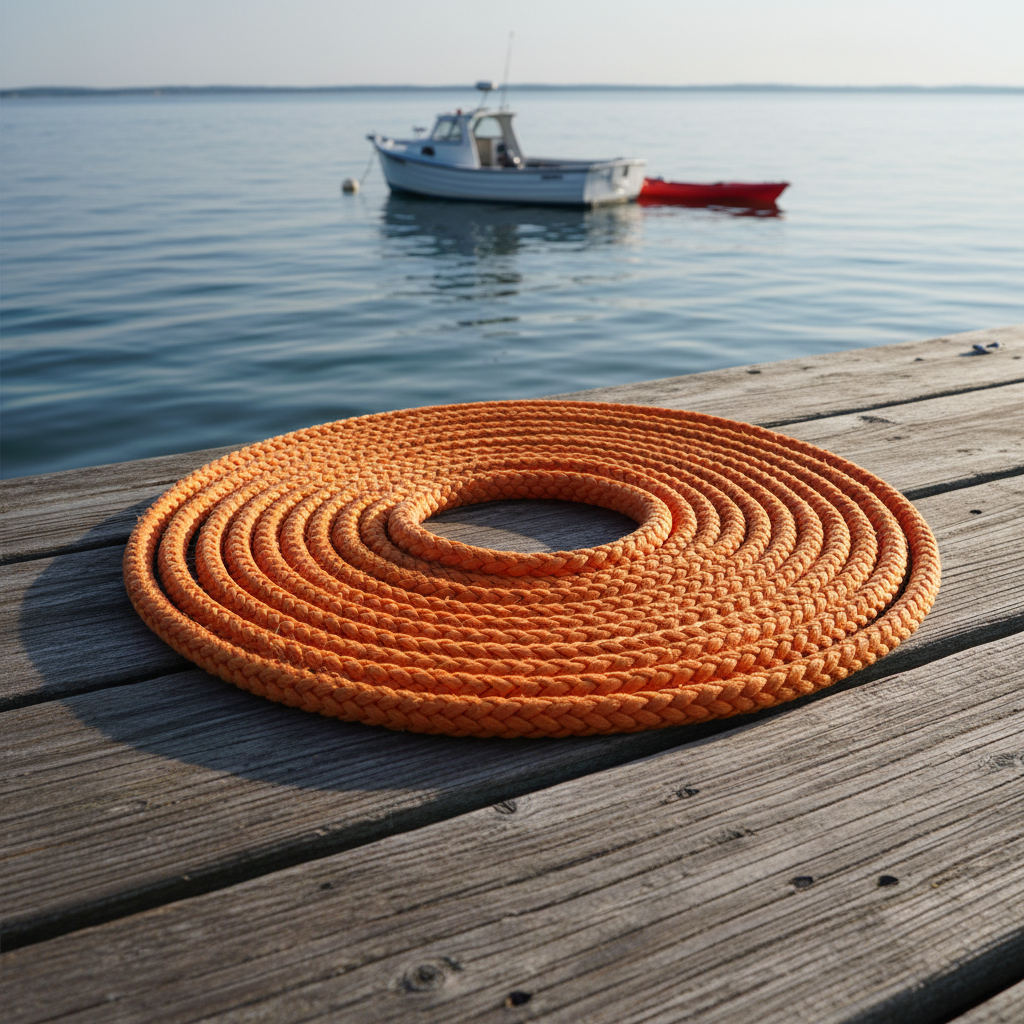A half-inch steel cable can lift up to 5,300 lb (WLL), while a half-inch nylon rope effectively handles 1,300 lb and weighs significantly less.
Read in ≈1 min – What you’ll gain
- ✓ Achieve up to 30% shipping weight reduction by selecting the optimal rope.
- ✓ Potentially reduce downtime by approximately 20% with corrosion-resistant nylon or stainless-steel finishes.
- ✓ Benefit from ISO 9001-backed quality and IP-protected custom branding.
- ✓ Receive a personalised quote for your specific needs within 24 hours.
You may have been told that steel consistently outperforms nylon in raw strength, but the ideal choice truly depends on the load profile and environmental conditions—nuances rarely detailed in standard spec sheets. This article will explain why a half-inch nylon rope can reduce weight, absorb shock, and even surpass steel in marine applications. Furthermore, discover how iRopes' custom-tailored options allow you to fine-tune diameter, coating, and accessories to meet your precise safety margins.
Understanding the half inch steel cable
Now that you understand why selecting the appropriate 1/2 inch line is crucial for heavy-duty tasks, let's explore the half inch steel cable itself. This type of wire rope serves as a foundational component in many industrial setups, providing the inherent strength required when safety is paramount.

Typical constructions you’ll encounter
- 6x19 IWRC – Features six strands, each with nineteen wires, plus an independent wire rope core (IWRC) for enhanced flexibility.
- 7x19 IWRC – Comprises seven strands with nineteen wires per strand, often preferred for applications requiring rotation resistance.
- 7x7 Compact – Utilizes seven strands of seven wires, offering a high strength-to-weight ratio and a reduced lay.
Each construction significantly influences both the Minimum Breaking Strength (MBS) and the Working Load Limit (WLL). For example, a standard 6x19 galvanized half inch steel cable typically possesses an MBS of around 26,600 lb. Applying the common safety factor of five, its WLL is approximately 5,300 lb. So, how much weight can a half inch steel cable truly hold? In practical terms, you can safely lift just over two tonnes when adhering to the recommended WLL.
Where the half inch steel cable excels
- Rigging & lifting – Provides critical support for structural loads on construction sites and in shipyards.
- Winching applications – Powers off-road recoveries, industrial winches, and various heavy-duty hoisting operations.
- Guy-wire systems – Essential for stabilising tall poles, temporary scaffolding, and antenna masts.
“When I needed a line that would withstand constant abrasion and still hold a 4-tonne load, the 7x19 IWRC half inch steel cable proved unbeatable – it maintained its shape and never showed signs of fatigue.” – Senior rigging supervisor, offshore project.
The advantages of the half inch steel cable are evident: it offers exceptional tensile strength, superior abrasion resistance, and predictable, low-stretch behaviour that simplifies load calculations. However, it does have limitations. The cable's weight can be a significant drawback in portable setups. Furthermore, unless you opt for a stainless-steel or coated variant, corrosion will inevitably become an issue in salty or humid environments. Cost is also a factor, as it tends to be higher than many synthetic alternatives, particularly for premium finishes.
Understanding these strengths and trade‑offs is key to determining if a half inch steel cable is the right fit for your project's demands. Now, let’s broaden our perspective to the wider range of half inch cable options and discover the subtle differences that can significantly impact your application.
Exploring the half inch cable options
Having understood how a half‑inch steel cable performs under load, you might be curious about how the broader category of half inch cables compares. The distinction between a generic half inch cable and its specialised steel variants often dictates whether a project proceeds smoothly or encounters unexpected complications.

In simple terms, a "half inch cable" can encompass anything from a basic synthetic line to a robust wire rope. Steel‑based half inch cable variants—galvanised, stainless, or coated—are specifically engineered for high‑load environments. Conversely, non‑steel options, such as nylon‑coated or polymer‑wrapped cables, prioritise flexibility and a lighter weight. If you require a line that resists corrosion in salty sea air, stainless steel is the superior choice; however, if your budget is constrained and exposure is minimal, a galvanised finish might be sufficient.
Material impact
Galvanised steel provides reliable corrosion protection at a competitive price point, though it remains susceptible to rust if its coating is compromised. Stainless steel (typically AISI 304 or 316) offers superior resistance to both moisture and chemicals, thereby extending its service life in harsh marine or chemical plant environments. Coated cables—often encased in nylon or PVC—offer an additional barrier against abrasion and UV exposure, while also providing a smoother surface for easier handling.
When you ask, "How much weight can a half inch steel cable hold?" the answer fundamentally depends on its construction and applied safety factor. The basic principle involves dividing the Minimum Breaking Strength by five; the resulting Working Load Limit typically falls within the low‑tonne range, which is generally adequate for most rigging and winching operations.
Key specifications to weigh
- Strength – MBS and WLL values vary significantly by construction (e.g., 6x19, 7x19 IWRC).
- Corrosion resistance – Options include galvanised, stainless, or various coated finishes.
- Flexibility – The core composition, whether wire rope or solid polymer sheath, directly affects handling.
- Cost – Material choice and finish are primary drivers of the price per foot, with stainless steel generally commanding a premium.
By considering these factors, you can effectively match the cable to its intended environment: a stainless 7x19 half inch cable for offshore lifting, a galvanised 6x19 version for static construction supports, or a coated cable when a smoother feel is needed for frequent splicing. Regardless of your choice, iRopes can customise the diameter, length, and colour, and even add bespoke terminations to integrate seamlessly into your workflow.
With the material landscape now clearer, let’s shift our focus to a popular synthetic alternative favoured by many marine and recreational users: the half inch nylon rope.
Choosing the right half inch nylon rope
Transitioning from steel to synthetics, the half inch nylon rope offers a lighter feel and a natural elasticity that can protect fragile loads. If your application demands a line that floats, resists UV degradation, and can withstand occasional abrasion from a dock or during towing, nylon is frequently the material of choice.

Two primary constructions dominate the market. The traditional 3‑strand twist offers simplicity and dependable performance, whereas a double‑braid layout packs more fibres into the same diameter for increased tensile capacity. Additionally, some manufacturers provide a hybrid core that combines a fibre centre with outer braids, designed to better dampen shock loads during towing operations.
Construction Types
How the rope is built
3-Strand
Twisted strands provide a classic feel and moderate stretch, making them suitable for general purpose lifting.
Double Braid
This two‑braid design delivers higher strength and smoother handling, ideal for marine docking applications.
Hybrid
Combines a fibre core with outer braids, offering enhanced shock absorption for towing and dynamic loads.
Strength Data
Typical MBS & WLL
3-Strand
An MBS of approximately 5,750 lb equates to a WLL of roughly 1,150 lb when applying a 5‑factor safety.
Double Braid
With an MBS between 6,500 lb and 8,156 lb, this yields a WLL ranging from 1,300 to 1,630 lb.
Hybrid
Offering an MBS close to 7,200 lb, this construction provides a WLL of about 1,440 lb for dynamic applications.
So, how strong is a half inch nylon rope? A standard 3‑strand construction can withstand approximately 5,750 lb before breaking, while higher‑grade double‑braid versions can exceed 8,000 lb. Our Nylon Rope Tensile Strength guide provides the full testing data and safety‑factor calculations.
Nylon's ability to float and stretch under load makes it exceptionally useful in marine applications such as docking, boat‑to‑dock lines, and towing, where its elasticity reduces shock on vessels. Outdoor recreation, including camping winches or kayak lifts, also benefits from nylon rope’s resistance to UV‑induced degradation and its relatively light weight compared to steel alternatives.
Key Takeaway
Nylon ropes offer an excellent balance of strength and flexibility, making them ideal when weight reduction and shock absorption are critical factors.
With its performance profile clearly laid out, you can now weigh nylon against the steel options and decide which line best suits your environment, load‑range, and maintenance preferences. Next up, we’ll directly compare steel and nylon to determine which factors will tip the scale for your specific project.
Comparison, customization, and buying guide
Having examined the individual characteristics of each line, it’s time to place the half inch steel cable and the half inch nylon rope side by side. Our goal is to highlight which attributes are most crucial for your specific environment and load requirements.

The comparative overview below distils the most critical factors—strength, durability, flexibility, and cost—allowing for clear decision‑making without overwhelming you with excessive specifications.
Strength (Steel)
MBS up to 27,000 lb; Working Load Limit (WLL) near 5,400 lb with minimal stretch.
Durability (Steel)
Resists abrasion and high temperatures; corrosion effectively mitigated by stainless steel or protective coatings.
Strength (Nylon)
MBS up to 8,200 lb; Working Load Limit (WLL) roughly 1,640 lb, offering essential elastic give.
Flexibility (Nylon)
High elasticity absorbs shock efficiently; UV‑stabilised coating protects against sun‑induced degradation.
When making your decision, consider three practical questions: Is the operational environment corrosive or heavily exposed to UV? Does the load require near‑zero stretch, or would some elasticity be beneficial? What budget constraints are guiding your material choice? Answering these will effectively steer you towards either the inherent strength of a steel‑based half inch cable or the lighter, shock‑absorbing properties of a half inch nylon rope. Our Steel Cable Hardware vs Rope Hardware comparison dives deeper into selecting the right fittings for each material.
Always inspect both steel and nylon lines thoroughly before each use; check for broken strands, corrosion on steel, or frayed fibres on nylon, and promptly replace any compromised sections.
iRopes transforms this decision‑making process into a streamlined ordering experience. Explore our Steel Cable Hardware vs Rope Hardware guide for detailed hardware recommendations. Our OEM/ODM team can precisely select the ideal material—be it galvanised, stainless steel, or marine‑grade nylon—adjust length to your specifications, add colour‑coded markings, terminate ends with loops or thimbles, and provide all necessary certifications. Because every batch adheres to ISO 9001 standards, you receive a product that precisely matches your approved specification, all while safeguarding your intellectual property (IP).
With a clear comparative view, practical maintenance advice, and a custom‑order pathway, you are well‑equipped to choose the optimal line to keep your project safe, efficient, and within budget.
Need a personalised line solution?
After thoroughly exploring the strength, flexibility, and environmental considerations of both steel and synthetic rope options, you now possess a clear framework for selecting the ideal line. Whether your project demands the raw power of a half inch steel cable, the versatile handling of a general half inch cable, or the lightweight resilience of a half inch nylon rope or even a half inch Dyneema rope, iRopes can precisely tailor the diameter, length, colour, and terminations to your exact specifications. Our comprehensive catalogue includes various 1/2 inch ropes, such as half nylon rope, ready for wholesale delivery. Discover how nylon ropes stack up against steel for your applications.
For a custom quote or expert advice tailored to your specific application, simply complete the enquiry form above, and our dedicated rope specialists will promptly provide you with a personalised solution.